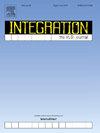基于微调时基自适应采样技术的低功耗SAR ADC在180nm CMOS上的心电监测应用
IF 2.2
3区 工程技术
Q3 COMPUTER SCIENCE, HARDWARE & ARCHITECTURE
引用次数: 0
摘要
本文提出了一种自适应采样SAR模数转换器(ADC),该转换器采用一种新颖的基于时间的微调采样技术,可以根据输入心电信号的特征动态调整正常和异常心电信号的采样率。通过集成机器学习,ADC可适应不同的信号条件,确保准确捕获基本数据,同时保持能源效率,从而提高便携式和可穿戴健康监测设备的有效性。与传统方法不同,模拟前端使用基于时间的技术,有效地识别和数字化ECG信号中存在的所有关键信息。此外,ADC采用可变分辨率方案,提高了功率效率并减少了数据带宽。ADC自适应地将更多的位分配到ECG波形的最重要部分,同时通过采用基于时间的方法降低非关键段的分辨率。这样可以实现高效的数据表示并降低总体数据传输需求,从而使该体系结构更加节能。该ADC采用180nm CMOS技术,在1.8 V电源下功耗仅为498.6 μW, ENOB为5.21位,SNDR为31.76 dB, SFDR为44.31 dB。该结构的采样频率范围为64hz ~ 512hz,适合便携式心电监测应用。在64 ~ 512 Hz的采样率下,所提出的工作的FoM范围分别为100 ~ 262 fj/转换步长。本文章由计算机程序翻译,如有差异,请以英文原文为准。
A low power SAR ADC with fine–tuned time based adaptive sampling technique for ECG monitoring application in 180 nm CMOS
This work proposes an adaptive sampling SAR Analog-to-Digital converter (ADC) with a novel fine-tuned time-based sampling technique to dynamically adjust the sample rate for normal and abnormal ECG signals based on the characteristics of the incoming ECG signal. By integrating machine learning, the ADC adapts to varying signal conditions, ensuring accurate capture of essential data while maintaining energy efficiency, thereby enhancing the effectiveness of portable and wearable health monitoring devices. Unlike conventional methods, the Analog front end uses a time-based technique that effectively identifies and digitizes all critical information present in ECG signals. Additionally, the ADC incorporates a variable resolution scheme, enhancing power efficiency and reducing data bandwidth. The ADC adaptively allocates more bits to the most significant portions of the ECG waveform while reducing the resolution for less critical segments by employing a time-based approach. This enables efficient data representation and reduces overall data transfer requirements, making this architecture more power-efficient. Implemented in 180 nm CMOS technology, the proposed ADC consumes only 498.6 μW with a 1.8 V supply and achieves ENOB of 5.21 bits, SNDR of 31.76 dB, and SFDR of 44.31 dB. The sampling frequency of the proposed architecture changes from 64 Hz to 512 Hz, which is suitable for portable ECG monitoring applications. The FoM of the proposed work ranges from 100 to 262 fj/conversion-step for 64–512 Hz sampling rate, respectively.
求助全文
通过发布文献求助,成功后即可免费获取论文全文。
去求助
来源期刊

Integration-The Vlsi Journal
工程技术-工程:电子与电气
CiteScore
3.80
自引率
5.30%
发文量
107
审稿时长
6 months
期刊介绍:
Integration''s aim is to cover every aspect of the VLSI area, with an emphasis on cross-fertilization between various fields of science, and the design, verification, test and applications of integrated circuits and systems, as well as closely related topics in process and device technologies. Individual issues will feature peer-reviewed tutorials and articles as well as reviews of recent publications. The intended coverage of the journal can be assessed by examining the following (non-exclusive) list of topics:
Specification methods and languages; Analog/Digital Integrated Circuits and Systems; VLSI architectures; Algorithms, methods and tools for modeling, simulation, synthesis and verification of integrated circuits and systems of any complexity; Embedded systems; High-level synthesis for VLSI systems; Logic synthesis and finite automata; Testing, design-for-test and test generation algorithms; Physical design; Formal verification; Algorithms implemented in VLSI systems; Systems engineering; Heterogeneous systems.
 求助内容:
求助内容: 应助结果提醒方式:
应助结果提醒方式:


